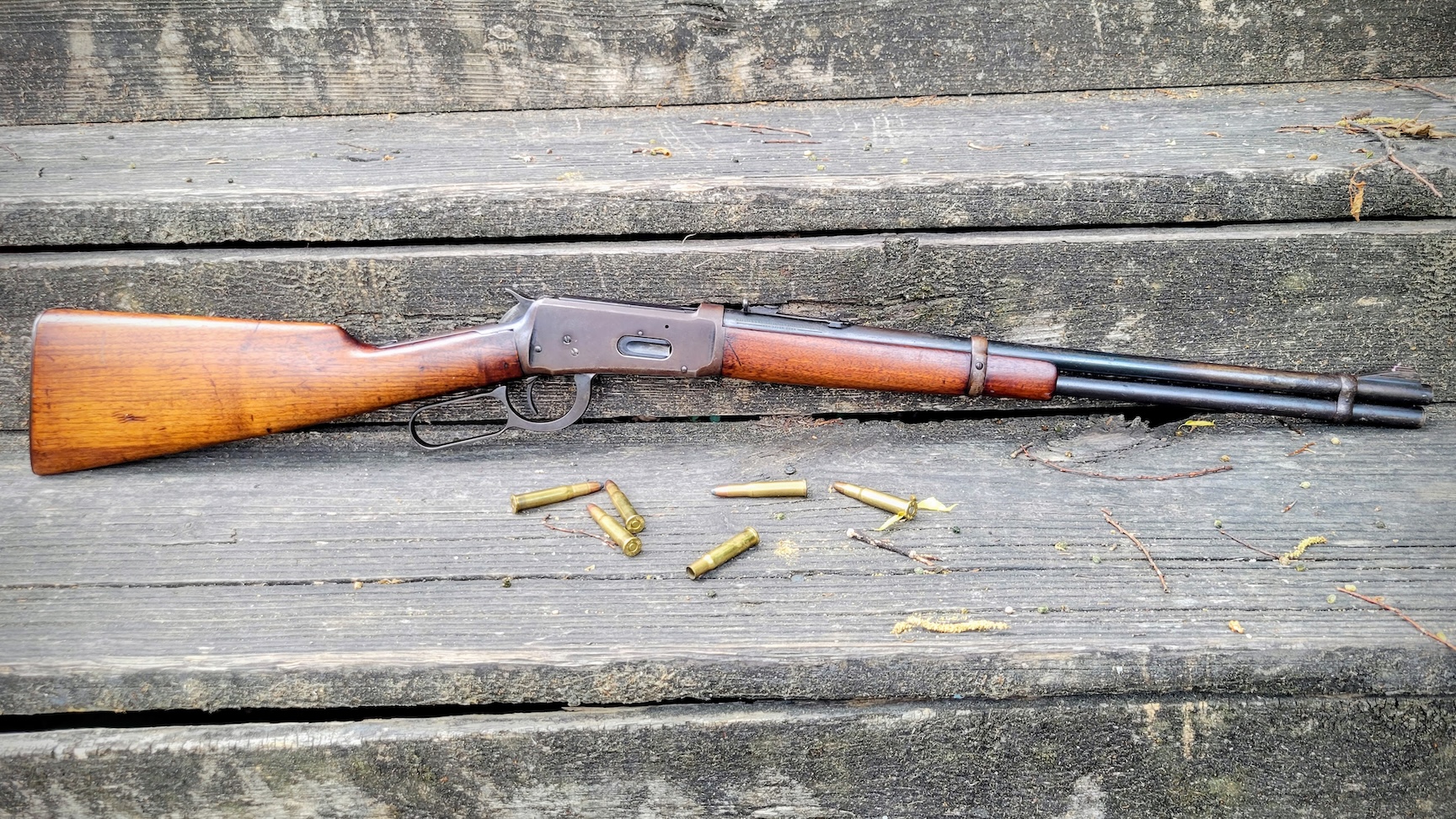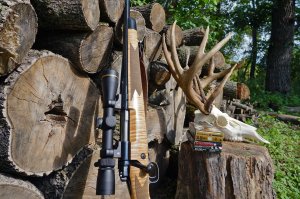When John Q. Citizen packs the family automobile and heads out for his annual deer hunt, the chances are that the rifle in the back seat, along with the side of bacon and the coffeepot, is a .30/30. John Q. may be a California fruit grower, a Pennsylvania steel worker, an Illinois clerk. He may be after white-tails, blacktails, or mule deer. But wherever he lives, whatever he hunts, he is probably armed with a .30/30.
To the great bulk of America’s hunters, the terms “deer rifle” and “.30/30” are practically synonymous, and the .30/30 has probably killed more deer than any other rifle ever made. In that respect, its only rival is probably the old .44/40. The .30/30 has been on the market since 1894·, not far from half a century, and by 1927 a million Model 94 Winchesters had been sold, most of them chambered for it. Strange as it may seem, the Model 94 carbine in .30/30 caliber is still Winchester’s best seller, and .30/30 cartridges lead the list for all ammunition companies.
Besides the familiar Model 94 carbine and its better stocked and more expensive version, the new Model 64, many other arms have been chambered for the good old “thutty-thutty” — the Savage Model 99, the Marlins, even the Model 54 Winchester bolt-actions, and the Savage Models 40 and 45. The caliber has also been a favorite for combination guns imported from Europe. The Savage utility gun may be obtained with a .30/30 barrel. Remington, so far as I know, has neve• produced a .30/30 rifle, but the .30 Remington cartridge is simply a rimless version of the .30/30, with almost identical ballistics, just as the .25 Remington is a rimless edition of the .25/35.
All in all, then, there are probably more than 2,000,000 rifles chambered for the .30/30 floating around North America. Most of them, if the relics I have seen are any indication, are still in use. They are shooting polar bears and caribou in the Arctic, moose in Canada, deer all over the United States and Mexico. In the Mexican revolutions, the .30/30 Winchester carbine was one of the principal military rifles in use. I have seen whole squads of soldados armed with that weapon. In the 1929 revolution I met an amiable gentleman who was in the United States to buy and smuggle rifles to his compadres south of the line. He was interested in just two calibers —— the .30/30 and the .30/06.
Yet in spite of its enormous popularity the .30/30 is probably the most damned cartridge ever manufactured. Gun writers have been almost unanimous in denouncing it as a fraud, a frost, and a delusion. The battle lines of the famous lever vs. bolt controversy had the Springfields on one side and the .30/30’s on the other. The print that has been used to prove the .30/30 a piece of cheese would fill several copies of OUTDOOR LIFE — maybe several dozen.
Why, then, does the good old “thuttythutty” remain the perennial best seller among game rifles? Why does John Q. Citizen continue to go into his favorite sporting-goods store and slap his coin on the counter for the rifle and its ammunition as a matter of course?
In the first place, tradition has made it the rifle he thinks of first. The .30/30 is the cartridge which weaned American hunters from black powder, and it has never lost the start it got. In the second place, rifles made in this caliber are usually light, short, and handy. They look like “deer rifles” and not “army rifles,” as many hunters term any bolt action. For another thing, rifles in .30/30 caliber are usually cheaper. The Model 94 carbine, for example, sells for around thirty bucks in contrast to approximately seventy dollars which is asked for most bolt-action rifles fitted with receiver sights. A further consideration is that even in a light carbine the recoil of the .30/30 is mild and does not bother a man who shoots only a box or two of cartridges a year. Believe me, that is no small factor in the popularity of this old caliber. The average man simply does not like the recoil of rifles of the .30/06 class, and he finds he can shoot his old .30/30 a lot more accurately than he can the .30/06 which was recommended to him.
The owner of a .30/30 need never worry about his ammunition supply. From the Arctic Circle to the tropics, any dealer who carries ammunition at all carries these cartridges. Then again, the various .30/30 rifles seem able to stand astounding neglect, and still function. I have seen such rifles that haven’t been cleaned for twenty years, have seen them with stocks worn almost completely away, with all the rifling gone from the barrel. Yet they still function-and still kill game.
For a handy saddle rifle, there has never been one better than the Winchester, Savage, or Marlin carbine. They all are flat, short, light. A cattleman riding the range on the lookout for lobos or coyotes can stick a carbine in his scabbard and forget it, whereas a bolt-action rifle tends to throw his leg out of line and make it cramp. A heavy rifle also unbalances his saddle to some extent. Before their manufacture became illegal, hundreds of ’94 carbines with fifteen-inch barrels were sold annually to cattlemen.

Last but not least, the .30/30 cartridge has, in the main, always delivered the game. If it had not, it would never have achieved its enormous popularity. It is, surely, no elk or moose cartridge, although elk and mooseplenty of them-have been killed with it. But as a cartridge for deer and black bear it is satisfactory.
I have killed deer with a .30/30, and I own a .30/30 now. I have examined many deer that were shot with that cartridge and with similar ones. For several years my wife hunted exclusively with the .25 Remington, which is the rimless adaptation of the .25/35, a smaller edition of the .30/30. Any deer shot in the lung area with a .30/30 will shortly be a dead deer, just as dead as if he had been shot with a .375 Magnum. Ordinarily, he won’t be knocked off his feet, unless he is hit in the head or neck, or in the spine. He will travel from fifty to 200 yards and lie down. When the hunter arrives, his buck will usually be too sick to get up. I have seen many animals, hit in the lungs with bullets of the .30/06-.. 270 class, killed instantly, dead before they hit the ground; but I have yet to see a .30/30 knock off a deer in that spectacular fashion. The point is this: With wellplaced shots, rifles of the .30/30 class bring home the bacon. Don’t let anyone tell you different. The 170 and 165- grain bullets nearly always shoot clear through, on broadside shots, and leave a good blood trail.
However, there is another side to the picture. Carelessly used, all rifles of the .30/30 class wound much game, as the bullets have neither the velocity nor the diameter to put an animal down and out when he’s hit in a nonvital spot. It is rare indeed that an animal hit squarely anywhere with a bullet from a .270 or a .30/06 is able to get away, because of the terrific shocking power of high-speed bullets. The same is true of old large-caliber bullets of low velocity, such as the .45/70.
Shot in the gut or the ham with a .30/30, a deer can run all day. Once I was hunting along the timbered side of a deep canyon, many years ago, when a big buck walked out of a grove of oaks and stopped to eat acorns, with his head and forequarters behind the trunk of a great pine. He had not sensed my presence, so I planned to wait until his head and shoulders came out, and then bust him. But there he stayed. It may have been a couple of minutes but it seemed like that many hours. I got nervous, lifted my .30/30, and let him have it right through the middle. He came out running as if he hadn’t been hit, and I proceeded to put another bullet about three inches from the first.
I chased that durable old buck most of the day. Several times I came quite close to him after laborious tracking, but he always managed to hear me and sneak out ahead. I finally came up to him just as he was struggling to get to his feet, and killed him with a neck shot. A more powerful rifle-or brains enough to wait for a better shot-would have saved me much hard work and anxiety.
In the hands of the good, careful, patient shot, the .30/30 is plenty of gun. It has killed tens of thousands of deer and will kill tens of thousands more before it is finally put on the shelf. However, it is not a gun for the poor shot, the excitable man, the fellow unable to track wounded game. It is no 300-yard rifle, and the man who just has to shoot at everything that has horns and that jumps, has no business with one.
And the .30/30 is no vermin rifle, in spite of the fact that thousands of coyotes have been killed with it. The man with a yen to shoot ‘chucks, coyotes, and jack rabbits had better get himself a rifle with a flatter trajectory.
Nor is the .30/30 a ‘scope rifle. A ‘scope can be mounted very neatly on a Model 99 Savage or on one of the solidtop Marlins. By the use of an offset mount, a ‘scope can also be put on a 94 or 64 Winchester. But putting a ‘scope on any .30/30 is something like putting a supercharger on a Model T Ford. It just ain’t good practice. The .30/30 doesn’t have the flat trajectory necessary to match the virtues of the ‘scope. However, a man with poor eyesight will gain by the use of a ‘scope on any rifle.
Probably the best bet for the rifle is one of the good tang peep sights such as those made by Lyman and Marble. Close to the eye as they are, such sights are probably the fastest made, particularly for use on fast-jumping game in the brush, where the .30/30 comes into its own. Most of them cost around five bucks, and they are well worth the money. Unless the .30/30 owner is incurably wedded to open sights he ought to give one of the aperture sights a whirl.
Accuracy? The .30/30 has plenty for deer hunting, the job for which it is intended, even with the thin, slotted barrels on some of the models. There is nothing about the .30/30 cartridge itself which would make it necessarily inaccurate, so far as I have been able to tell. Shoot even a .257 Roberts, which has a red-hot reputation for accuracy, through a worn-out, rusted barrel with a couple of sight slots cut into it, and the .257 won’t be any more accurate than a .30/30 shot through a similar barrel. Some years ago I ran across a Model 54 Winchester in .30/30 caliber, one fitted with a good ‘scope. I borrowed that little rifle, went out to a range, and tried shooting groups with some Remington ammunition I had. Not one of the groups was larger than three inches at 100 yards, and one ran only a bit over 1 ½ inches. Moral? It’s the barrel, the bedding, and the sights that produce ordinary group accuracy.
However, just recently, with a Model 94 carbine and open sights, a five-inch group was the best that I could do. But your correspondent isn’t used to open sights, and at the time he was out of practice on that particular trigger pull. So far as cartridges for the time-tried little .30/30 are concerned, the man who fancies that caliber had better stick to the 165 and 170-grain soft points. They are by far the best killers. The .30/30 has a small powder capacity, and simply cannot be given a high velocity with a good bullet. When it was brought out, back in 1894, the cartridge had a muzzle velocity of a bit less than 2,000 feet a second. Now, in spite of the great improvement in powders, the original 170- grain bullet only travels at 2,200. Any increase in speed over those figures is gained at a sacrifice of sectional density — the relation of length to diameter. As it stands, the 170-grain bullet has fair sectional density, enough for deer at the speed with which it travels, and that 170-grain bullet is the one which made the caliber its reputation.

Reduce that bullet weight by twenty grains to 150, and the increase in velocity is only 180 feet a second, or 2,380. Cut the bullet weight to 110 and the velocity is 2,720. However, the 110-grain bullet has a very poor sectional density, and with its round nose it sheds that illgotten speed so swiftly that out at 100 yards it is traveling at only 2,260. It has lost close to 500 feet a second of velocity. Result? A bullet without the speed to kill by shock, and without the sectional density to drive into the vitals.
Another little consideration is that most existing .30/30 barrels are very sensitive to changes in bullet weight and powder charge. And most .30/30 rifles don’t have easily adjustable sights. So the smart thing for the .30/30 user to do is to stick to the old fodder. The .30/30 simply isn’t a .30/06, and there’s no way it can be pepped up to .30/06 ballistics.
Practically everything I have said about the .30/30 can also be applied to its various relatives, cartridges all of medium velocity and medium power, all popular for deer shooting.
All these cartridges are of about the same vintage, and in characteristics they are much alike. In their best loadings, they all carry fairly heavy bullets for their respective calibers at moderate velocities. All have a trajectory height midway 200 yards, of around five inches, which means that the man who uses one should sight his rifle in to hit point of aim at 150 yards, and hold a bit higher on the animal if he thinks he is farther away. All of them kill deer well with correctly placed shots, poorly with sour shots-just like their eminent cousin.
The .25, .30, and .32 Remingtons differ from the others in that they are rimless cartridges, like the .30/06, instead of rimmed cartridges, like the .30/30. Designed for Remington pump and auto-rifles, they were adapted from the old .25/35, .30/30, and .32 Special cartridges, the ballistics of which they duplicate.
Read Next: Why the Winchester 94 Is (and Always Will Be) My Favorite Deer Rifle
The .32/ 40 hardly belongs to this class (it is an old straight-taper shell originally made for black powder), but I have included it because smokeless powder and modern loadings make it almost the equal of the .30/30.
The .25/35 is just a little .30/30, and owing to the good sectional density of its 117-grain bullet, it seems to be just about as effective a killer as its big brother. The .303 Savage, on the other hand, is a bigger .30/30 with a heavier bullet. I have never used one, but in the backwoods it has quite a reputation. Its heavier bullet should make it somewhat more effective than the others, particularly on large animals.
But notice this, folks: Those old-timers who kill “the biggest” don’t shoot at ranges greater than 100 yards, and you can bet that before they pull the trigger they have those moose and grizzlies dead to rights. They don’t blast away at everything that jumps within 300 yards, and expect their little .30/30’s to perform like so many .270’s. They know better!
Read the full article here






![Cartels, Terror Groups Targeting ICE Agents as Democrats Give Them ‘Air Cover’: Noem [WATCH] Cartels, Terror Groups Targeting ICE Agents as Democrats Give Them ‘Air Cover’: Noem [WATCH]](https://www.lifezette.com/wp-content/uploads/2025/08/2025.08.15-04.14-lifezette-689f5cf3641af.jpg)





![Bodycam Shows Police Rapid Response, Killing of Mass Church Shooter in Michigan [WATCH] Bodycam Shows Police Rapid Response, Killing of Mass Church Shooter in Michigan [WATCH]](https://www.rvmnews.com/wp-content/uploads/2025/10/2025.10.05-03.22-rvmnews-68e28d47c5c81.jpg)
